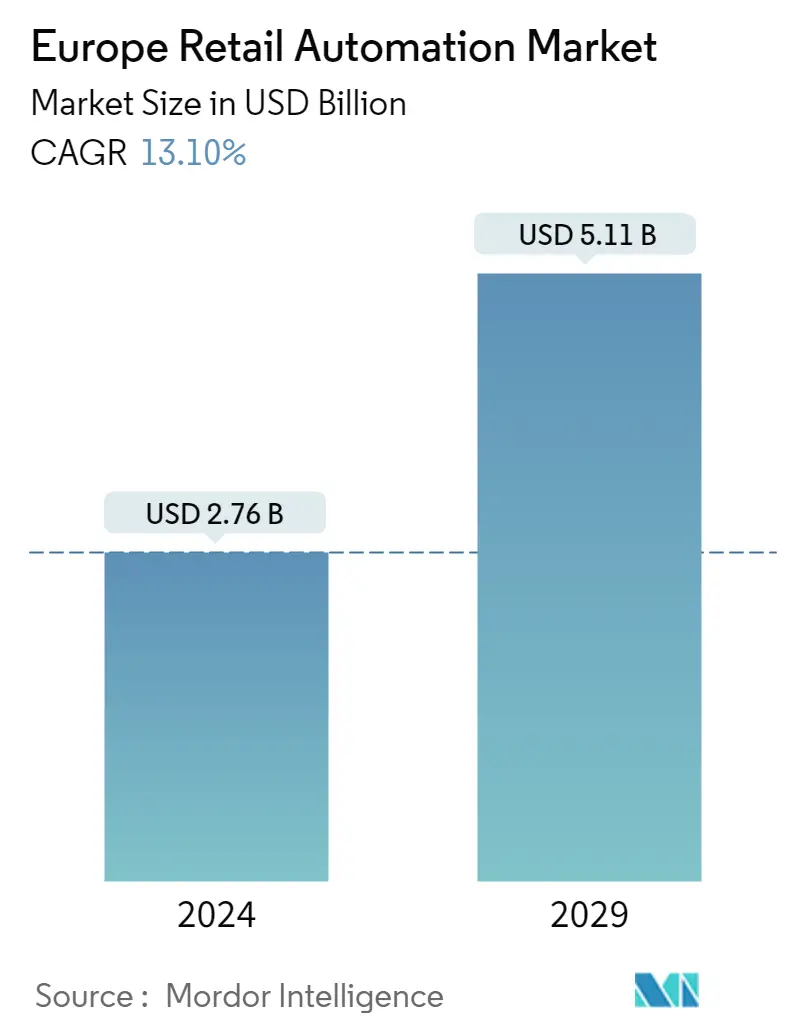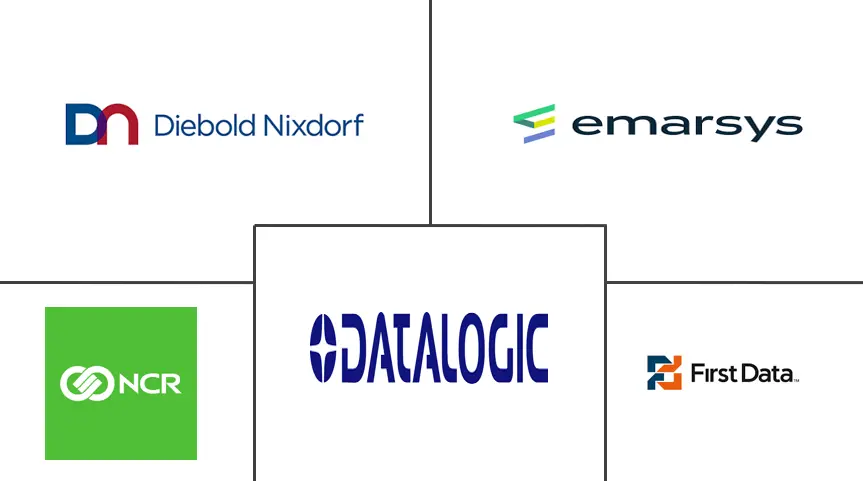Market Size of Europe Retail Automation Industry

| Study Period | 2019 - 2029 |
| Base Year For Estimation | 2023 |
| Market Size (2024) | USD 2.76 Billion |
| Market Size (2029) | USD 5.11 Billion |
| CAGR (2024 - 2029) | 13.10 % |
| Market Concentration | Medium |
Major Players
*Disclaimer: Major Players sorted in no particular order |
Europe Retail Automation Market Analysis
The Europe Retail Automation Market size is estimated at USD 2.76 billion in 2024, and is expected to reach USD 5.11 billion by 2029, growing at a CAGR of 13.10% during the forecast period (2024-2029).
- Due to rising inflation, consumers adjusted by spending less, turning to recommerce, and adapting to substitutes. According to Insee, Monthly household expenditure on consumer goods in France decreased from 48.9 thousand USD in January 2021 to 44.9 thousand USD in January 2022. The retailers recognized the need for automation after observing the increase in footfall.
- The European Union has established a forward-looking goal for AI. By 2030, 75% of European businesses will reportedly use AI. The framework puts a lot of emphasis on introducing various cross-border projects, combining EU funding with national governments and private investors. Cloud computing, big data, and AI will be utilized by three out of every four businesses by 2030. The proportion of unicorns in the European Union should treble, and more than 90% of SMEs should achieve at least a basic level of digital intensity.
- March 2022 - To improve its logistics and inventory infrastructure, MQ Marqet, a Swedish fashion retailer, adopted AutoStore, an automated goods-to-person developed by DB Schenker. The system uses warehouse robots to deliver and retrieve bins for operators. The application also takes care of e-commerce and store-replenishment operations.
- During the early stages of the COVID-19 pandemic, when there was a labor shortage, delivery slots were few, and customer demand was high, demand for click-and-collect models surged. These models assisted grocery stores in reaching customers outside urban areas, including suburbs, small communities, and even rural locations. Ocado developed grocery-picking robots that will enable cheaper, quicker deliveries and help with labor shortages.
Europe Retail Automation Industry Segmentation
Conventional management requires too much time, effort, and money, which reduces an organization's profitability. Retailers are adapting to AI technologies to automate their business framework to overcome these challenges. Accessing and using available data to enhance operations and the in-store experience is made simple through automation. Retail automation often manages time-consuming, repetitive processes, which saves a lot of time. This technology enhances the customer experience in some ways, including tailored marketing automation, automated customer service, and speedy order fulfillment.
The European retail automation market is segmented by type (hardware (POS system, self-checkout system, RFID and barcode scanners, and other hardware) and software), end user (grocery (supermarkets, hypermarkets, convenience stores (with and without fuel), and drugstores), general merchandise (hardgoods, softgoods, and mixed general merchandise, like departmental stores, etc.), hospitality (hotels (including casinos, resorts, cruise ships, etc.) and restaurants)), and Country (United Kingdom, Germany, France, and Rest of Europe).
The market sizes and forecasts are provided in terms of value (USD) for all the above segments.
| By Type | ||||||
| ||||||
| Software |
| By End User | |
| Grocery | |
| General Merchandise | |
| Hospitality |
| By Country | |
| United Kingdom | |
| Germany | |
| France | |
| Rest of Europe |
Europe Retail Automation Market Size Summary
The European retail automation market is experiencing significant growth, driven by the increasing adoption of advanced technologies such as artificial intelligence, cloud computing, and big data. Retailers across the region are investing heavily in these technologies to streamline operations, enhance customer experiences, and improve profitability. The market is characterized by a moderate level of competition, with key players like Datalogic, Toshiba Global Commerce, and Fujitsu Limited leading the charge. These companies are collaborating with retailers to implement automated solutions that reduce manual interventions and optimize business frameworks. The push towards automation is further supported by the European Union's ambitious goals for AI integration in businesses, aiming for widespread adoption by the end of the decade.
The demand for retail automation in Europe is also fueled by changing consumer behaviors and the need for efficient logistics and inventory management. The COVID-19 pandemic highlighted the importance of automation, as retailers faced labor shortages and increased demand for contactless shopping options. Innovations such as cashier-less stores, automated warehousing, and robotic assistance systems are becoming more prevalent, helping retailers manage traffic and streamline operations. Additionally, partnerships between retailers and technology providers are facilitating the development of solutions like Micro Fulfillment Centers and automated e-grocery pickups, which cater to the evolving needs of consumers. As a result, the European retail automation market is poised for substantial growth, with a focus on enhancing operational efficiency and customer satisfaction.
Europe Retail Automation Market Size - Table of Contents
-
1. MARKET INSIGHTS
-
1.1 Market Overview
-
1.2 Value Chain/Supply Chain Analysis
-
1.3 Industry Attractiveness - Porter's Five Forces Analysis
-
1.3.1 Threat of New Entrants
-
1.3.2 Bargaining Power of Buyers
-
1.3.3 Bargaining Power of Suppliers
-
1.3.4 Threat of Substitute Products
-
1.3.5 Intensity of Competitive Rivalry
-
-
1.4 Assessment of the COVID-19 Impact on the Industry
-
-
2. MARKET SEGMENTATION
-
2.1 By Type
-
2.1.1 Hardware
-
2.1.1.1 POS System
-
2.1.1.2 Self-checkout System
-
2.1.1.3 RFID and Barcode Scanners
-
2.1.1.4 Other Hardware Types
-
-
2.1.2 Software
-
-
2.2 By End User
-
2.2.1 Grocery
-
2.2.2 General Merchandise
-
2.2.3 Hospitality
-
-
2.3 By Country
-
2.3.1 United Kingdom
-
2.3.2 Germany
-
2.3.3 France
-
2.3.4 Rest of Europe
-
-
Europe Retail Automation Market Size FAQs
How big is the Europe Retail Automation Market?
The Europe Retail Automation Market size is expected to reach USD 2.76 billion in 2024 and grow at a CAGR of 13.10% to reach USD 5.11 billion by 2029.
What is the current Europe Retail Automation Market size?
In 2024, the Europe Retail Automation Market size is expected to reach USD 2.76 billion.

